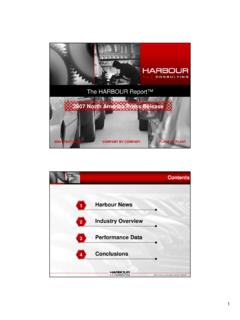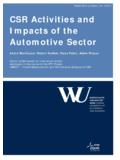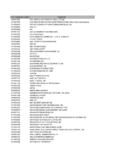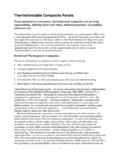Transcription of Global Automotive Declarable Substance List (GADSL)
1 2015 GADSL Version Page 1 of 40 Global Automotive Declarable Substance List (GADSL) 1. GADSL Objectives Major objectives of Automotive product development include continuous improvements in quality, safety, and the reduction of environmental impact throughout vehicle life cycle. As much as possible, these objectives should be achieved in an efficient, cost effective way to optimize consumer value. A large number of construction, operational and processing materials are used in the Automotive manufacturing chain, and their selection and proper use can have significant impact on these objectives. To meet these objectives, an ongoing dialogue and information flow within the Global Automotive supply chain, including automobile manufacturers, tier suppliers and material suppliers has been established, called the Global Automotive Stakeholder Group (GASG). Early information and dialogue up and down the supply chain will help facilitate compliance with current and future regulations, as well as take into account customer requirements to ensure sustainable products.
2 Optimized handling of relevant information flow can help automobile manufacturers meet existing and projected reporting requirements in a consistent, understandable and efficient way. The GASG organization consists of three regions, Americas, Europe/Africa/Middle East, and Asia/Pacific. Regional membership and participation is open to all stakeholders in the Automotive supply chain. Each of the three regions nominates six members to sit on the governing body of the GASG, called the Steering Committee (SC). The SC meets annually or more at its prerogative to decide on the GADSL and to provide a transparent and open process for decision making. The product of the GASG dialogue is the Global Automotive Declarable Substance List (GADSL). The GADSL covers declaration of certain information about substances relevant to parts and materials supplied by the supply chain to automobile manufacturers. The information is applicable to the use of these parts or materials in the production of a vehicle up to its usage and relevant to the vehicle s re-use or waste disposal.
3 Revision Date Revision Comment 2015-08-15 2015 update of the Substance list according to agreed dossiers. 2015 updates are highlighted in gray. 2015 GADSL Version Page 2 of 40 The intent of GADSL is to become the company specific list for declaration of parts composition within the Automotive industry. It provides a definitive list of substances requiring declaration with the target to minimize individual requirements and ensure cost-effective management of declaration practice along the complex supply chain. The scope is to cover Declarable substances in the flow of information relevant to parts and materials supplied throughout the Automotive value chain, from production to the end of life phase. The GADSL only covers substances that are expected to be present in a material or part that remains in the vehicle or part at point of sale. This approach is a voluntary industry initiative designed to ensure integrated, responsible and sustainable product development by automobile manufacturers and their supply chain.
4 Its purpose is to minimize individual requirements and ensure cost-effective management of declaration practice along the large and complex Global supply chain. 2. Application of the GADSL The use of certain substances in vehicle parts may be a risk factor to human health and the environment. Information exchange along the vehicle supply chain helps manage those potential risks while also meeting customer requirements. The GADSL is used to enhance further dialogue and cooperation along the supply chain on the benefits and potential risks of certain substances or groups of substances in a specified use within vehicle parts/materials. Declaration of a Substance does not mean, however, that the Substance is prohibited from being used in vehicle parts or is to be de-selected from use. Any declaration process using the GADSL must respect the framework formulated in this preface. Definitions Substances Chemical elements or chemical compounds as parts of materials or preparations Preparations Mixtures, composed of two or more substances Materials Chemical elements, chemical compounds or preparations thereof in finished state used to manufacture products/articles Products/articles Materials, which have been transformed during production to take a specific shape, surface or form, which has a greater influence on their function than their chemical composition does.
5 Parts Single components made up of one or more homogenous material(s) 2015 GADSL Version Page 3 of 40 Criteria for Declarable Substances The decision to list a Substance on the GADSL is based on the following criteria: The Substance should be expected to be present in a material or part in the vehicle. Either of the following conditions should apply: The Substance is regulated1, or is projected to be regulated by a governmental agency or authority, or It is demonstrated, by testing under OECD (Organization for Economic Cooperation & Development) guidelines for testing chemicals, conducted under Good Laboratory Practice (according to the OECD Principles on Good Laboratory Practice as revised in 1997), that the Substance may be associated with a significant hazard to human health and/or the environment, and its presence in a material or part in a vehicle may create a significant risk to human health and/or the environment.
6 Other scientifically valid methodology, based on the weight of evidence, may also be considered. A Substance that causes a functional problem in vehicle design may be included if its presence in a vehicle part exceeds a level shown to be problematic by an international industry standard test2. Reportable threshold levels will be based on the lowest level required by regulation or reasonably required by scientific evaluation. Declarable Substance Classification A reportable Substance when present in a material or part in a vehicle will be shown on the GADSL with a classification of P or D , defined as follows: Depending on its specific application, the same Substance could be classified P in one end use, and D in another end use. When this is the case, both classifications for the Substance will be shown on the GADSL with examples under the application column. Declaration thresholds are defined by specific application of the Substance in Automotive parts.
7 Any reportable Substance below the declaration level does not have to be reported. These levels, unless otherwise indicated, are g/100g (weight %) of non-separable, homogeneous materials, not on the total content in the component or assembly. P = Prohibited A Substance designated P is either prohibited by regulation for use in certain applications or may not exceed regulated threshold limits. 1 Due to potential effects on human health or the environment related to the Automotive industry 2 Examples would be emissions, like odor testing or fogging. Currently there are numerous tests. Development of a quantitative industry standard test would reduce resource requirement and uncertainty for the supply chain. 2015 GADSL Version Page 4 of 40 D = Declarable A Substance designated D must be declared if it exceeds the defined threshold limits.
8 Reason Codes Reason codes have been developed to explain why a Substance has been included in the GADSL. Each Declarable Substance will be listed with one of the following reason codes to facilitate dialog within the supply chain: LR = Legally Regulated A Substance legally regulated because its use in a vehicle part or material poses a significant risk to health and or the environment. FA = For Assessment A Substance projected to be regulated by government agencies, upon decision by the GASG Steering Committee. FI = For Information A Substance tracked for information purposes only, upon decision by the GASG Steering Committee. After discussion at the GASG Steering Committee and on an exceptional basis, an automobile manufacturer may include an individual Substance or family of substances on the list under this (FI) reason code. LR, FA and FI substances should not be construed to mean that the Substance is prohibited from being used in a vehicle part, or is to be de-selected from use.
9 Substance families: If all members of a Substance family are D or P the entry all members is listed after the family name. The entry Substance name, selected means: This Substance family refers to a limited list of single substances, which meet the criteria for being Declarable or prohibited. In certain cases Substance families have the classification "D, except". This means that all substances within that family are Declarable except those that are listed directly below labeled with "P" ( Polybrominated Diphenyl Ethers). CAS numbers for individual substances of a chemical family or group on the GADSL are listed in the Reference List which is part of GADSL. This list is available on the GADSL website. A 2006 priority of the GASG will be to review individual substances identified by CAS numbers on the reference list against GADSL criteria. The sole purpose of this reference list is to facilitate communication and declaration relating to the GADSL within the Automotive supply chain to the automobile manufacturers.
10 2015 GADSL Version Page 5 of 40 3. GADSL Validity The valid GADSL will be the current English version on The content of the GADSL and its application does not relieve parties in the supply chain from obligation to comply with all existing relevant regional and national regulations in their business to business dealings. 4. Change Management Process The GADSL will be updated and published annually in February according to improved knowledge in order to achieve a high standard of product safety and environment protection. At the latest 12 months after the publication date, any declaration should be performed according to this updated version. Requested changes to the GADSL must be received by July 15 each year in order to be considered for the next version. For this input, comments and questions please contact one of the persons listed on the GADSL website. 5. Listed substances The table on the following pages shows the substances that are covered by the GADSL.




